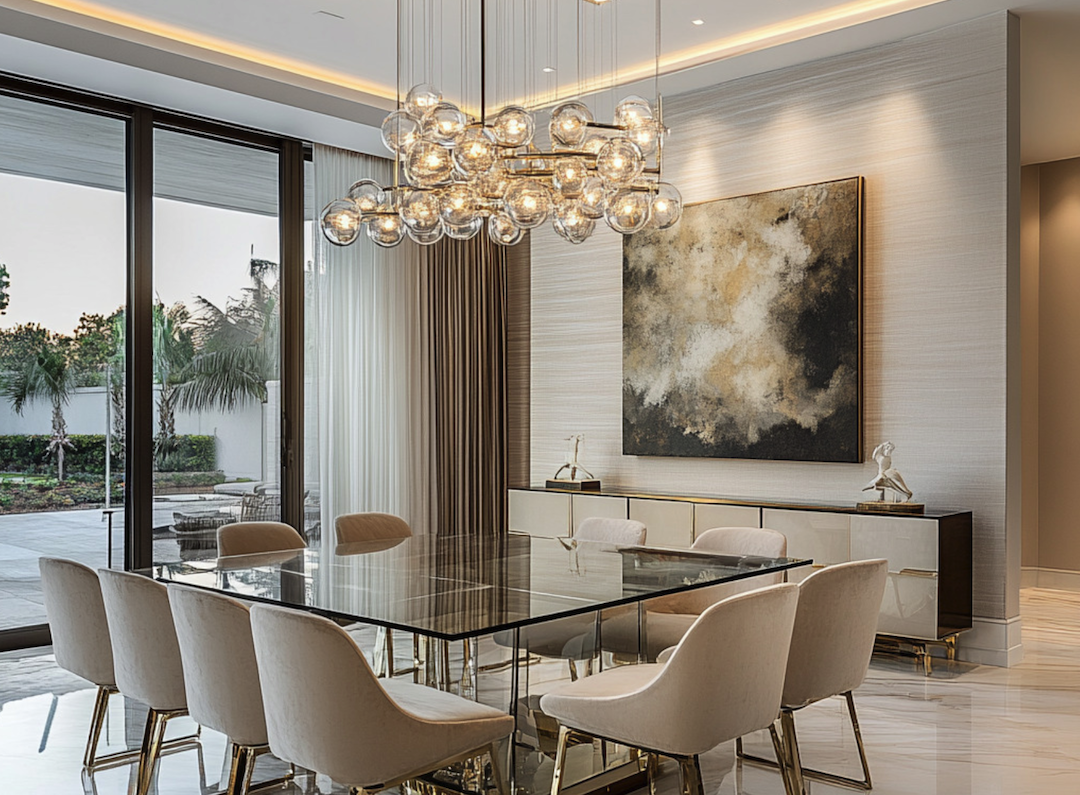
Effortless Elegance: Minimalist Dining Room Chandelier
Minimalism in interior design is a philosophy that emphasizes simplicity, functionality, and the beauty of essential elements. It strips away the superfluous, allowing the core features of a space to shine through. In the context of a dining room, this means creating an environment that is not only visually appealing but also conducive to social interaction and comfort.
The minimalist approach often involves a careful selection of furniture, color palettes, and decorative elements that work harmoniously together. By focusing on fewer items, each piece can be appreciated for its craftsmanship and design, leading to a serene and uncluttered atmosphere. The impact of minimalism on a dining room is profound.
An elegantly designed minimalist dining room can evoke feelings of calm and sophistication, making it an inviting space for gatherings. The use of open spaces, combined with thoughtfully chosen furnishings, allows for fluid movement and interaction among guests. For instance, a simple wooden dining table paired with sleek chairs can create a striking visual contrast against a backdrop of neutral walls.
This approach not only enhances the aesthetic appeal but also fosters a sense of connection among diners, as the environment encourages engagement rather than distraction.
Lighting plays a pivotal role in minimalist design, serving as both a functional necessity and an artistic element that can transform a space. In a minimalist dining room, the right lighting can accentuate the simplicity of the design while adding warmth and depth. Natural light Rodovida is often celebrated in minimalist spaces; large windows or glass doors can flood the room with sunlight during the day, creating an airy ambiance that complements the understated decor.
However, artificial lighting is equally important for evening gatherings, where it can set the mood and enhance the overall experience. When selecting lighting for a minimalist dining room, it is essential to consider fixtures that align with the design ethos. Pendant lights or chandeliers with clean lines and subtle designs can provide focused illumination while maintaining the simplicity that defines minimalism.
For example, a single pendant light hanging above a dining table can create an intimate atmosphere without overwhelming the space. The interplay between light and shadow can also add dimension to the room, highlighting architectural features or artwork while keeping distractions at bay.
Selecting the right chandelier for a minimalist dining room requires careful consideration of both aesthetics and functionality. A chandelier should enhance the overall design without becoming a focal point that detracts from the simplicity of the space. When choosing a chandelier, look for designs that feature clean lines and geometric shapes, as these elements resonate well with minimalist principles.
Materials such as metal or glass can provide a sleek finish that complements other furnishings while maintaining an air of sophistication. Another important factor to consider is scale. The size of the chandelier should be proportionate to the dining table and the overall dimensions of the room.
A large chandelier can create a dramatic effect in a spacious dining area, while smaller designs may be more suitable for compact spaces. Additionally, consider adjustable height options; this allows for flexibility in how the chandelier interacts with other elements in the room. A well-placed chandelier can draw attention to the dining table while ensuring that it does not overpower other design features.
Minimalist chandeliers often embody clean lines and simple shapes, which are essential characteristics of minimalist design. These elements contribute to an overall sense of elegance by eliminating unnecessary ornamentation and focusing on form and function. For instance, a chandelier featuring straight lines or circular forms can create visual harmony within a dining room that prioritizes simplicity.
Such designs allow for easy integration with various styles of furniture and decor, ensuring that they enhance rather than compete with other elements in the space. The use of geometric shapes in chandelier design can also evoke a sense of modernity while remaining timeless. A rectangular chandelier may complement a long dining table beautifully, while a round fixture can soften sharp angles in a more angular room layout.
The interplay between these shapes can create visual interest without overwhelming the senses. Furthermore, minimalist chandeliers often utilize materials like brushed metal or frosted glass, which not only contribute to their sleek appearance but also diffuse light in an inviting manner.
Neutral tones are synonymous with minimalist design, providing a calming backdrop that allows other elements to shine. When it comes to chandeliers, opting for designs in shades like white, gray, or beige can seamlessly integrate into a minimalist dining room while adding an air of sophistication. These colors reflect light beautifully and can enhance the overall brightness of the space without introducing visual clutter.
Additionally, neutral tones create versatility; they can easily adapt to changing decor styles or seasonal accents. Natural materials also play a significant role in achieving understated luxury within minimalist chandeliers. Wood, metal, and glass are commonly used materials that not only align with minimalist aesthetics but also bring warmth and texture to the dining room.
A wooden chandelier with clean lines can introduce an organic element that softens the starkness often associated with minimalism. Similarly, metal fixtures in matte finishes can add an industrial touch while remaining elegant. By incorporating these materials into chandelier designs, homeowners can achieve a balance between simplicity and sophistication that enhances their dining experience.
In any well-designed space, creating a focal point is essential for guiding the eye and establishing visual interest. In a minimalist dining room, a carefully chosen chandelier can serve as this focal point, drawing attention without overwhelming other elements in the space. The key lies in selecting a chandelier that embodies simplicity while still making a statement—this could be achieved through unique shapes or innovative materials that capture attention subtly.
For example, an oversized pendant light made from clear glass can act as an eye-catching centerpiece above a dining table while allowing light to filter through beautifully. This transparency maintains an open feel within the room while still providing an element of intrigue. Alternatively, a sculptural chandelier with an artistic flair can become a conversation starter among guests while enhancing the overall elegance of the dining area.
By thoughtfully positioning such fixtures within sightlines, homeowners can ensure that they contribute to both functionality and aesthetic appeal.
While aesthetics are crucial in selecting a chandelier for a minimalist dining room, functionality should never be overlooked. A chandelier must provide adequate lighting for various activities—whether it’s casual family dinners or formal entertaining—while still adhering to minimalist principles. This balance between style and function is essential for creating an inviting atmosphere where guests feel comfortable.
When evaluating potential chandeliers, consider their brightness levels and how they interact with other light sources in the room. Dimmable options are particularly advantageous; they allow homeowners to adjust lighting intensity based on occasion or mood. Additionally, chandeliers with multiple bulbs or adjustable arms can offer versatility in directing light where it’s needed most—overhead for dining or softer illumination for ambiance during gatherings.
By prioritizing both elegance and practicality in chandelier selection, homeowners can ensure their dining rooms remain functional yet stylish spaces.
Maintaining a minimalist chandelier is essential for preserving its beauty and functionality over time. Regular cleaning is crucial; dust accumulation can dull finishes and obscure light output. Depending on the materials used in your chandelier—be it glass or metal—different cleaning methods may apply.
For glass fixtures, using a soft cloth with mild soap or specialized glass cleaner will help maintain clarity without scratching surfaces. Metal components may require specific cleaners designed for their finish to avoid tarnishing or corrosion. In addition to routine cleaning, periodic inspections are necessary to ensure all bulbs are functioning correctly and securely fastened.
Replacing burnt-out bulbs promptly not only maintains optimal lighting levels but also prevents uneven wear on fixtures due to prolonged use of only partial lighting sources. Furthermore, checking electrical connections periodically ensures safety while prolonging lifespan; loose connections could lead to flickering lights or even electrical hazards if left unaddressed. By implementing these maintenance practices diligently, homeowners can enjoy their minimalist chandeliers’ effortless elegance for years to come without compromising on style or safety.

